“Not-for-EU” Labelling Delayed – What That Means for Food Brands in Great Britain

Food manufacturers in Great Britain have been given extra time to update their packaging, following the recent delay to the government’s “Not-for-EU” labelling scheme. Originally set to begin rolling out from October 2024, the introduction of the new labelling requirement has now been pushed back, offering a brief reprieve to businesses juggling compliance costs and changing market conditions.
What Is “Not-for-EU” Labelling?
The “Not-for-EU” label is part of the UK government’s post-Brexit border arrangements, designed to apply to food products sold only within Great Britain. It was initially intended to make product routes clearer, especially for goods moving through Northern Ireland under the Windsor Framework. Under the original plans, any food destined solely for sale in England, Scotland, or Wales would need to carry a clear “Not-for-EU” label, helping to prevent unauthorised movement of goods into the EU single market via Northern Ireland.
The policy faced criticism from many food producers, especially smaller businesses, who warned of increased packaging costs and confusion for consumers. Concerns were also raised about the limited rollout time and the challenge of keeping dual stock for EU and non-EU markets.
Why the Rollout Has Been Delayed
In July 2025, the UK government confirmed a delay to the “Not-for-EU” scheme’s introduction, citing the need to allow more time for industry preparation. The government acknowledged the pressures already facing manufacturers, from inflationary costs to supply chain disruptions, and agreed to extend the timeline before mandatory labelling begins.
No new official start date has been set, but the government has suggested a phased approach will follow, giving businesses longer lead-in periods depending on product type. This delay applies across most food categories sold in Great Britain, though certain high-risk products may face different rules later on.
What This Means for Food Businesses
For many food brands, the delay brings much-needed breathing room. Companies planning to redesign packaging now have more flexibility to adjust their timelines, helping to spread costs and avoid rushed production changes. It also allows additional time to engage with retailers, review supply chains, and determine whether dual packaging strategies are necessary.
The delay does not mean the rules will disappear. The government has made it clear the policy will still come into force in the future, meaning food businesses should continue preparing. Those supplying both GB and EU markets will still need to plan carefully, especially when balancing regulatory compliance with efficient stock management.
Packaging Plans Still Need Attention
The temporary pause on “Not-for-EU” labelling offers a short-term benefit but does not remove long-term packaging challenges. Businesses are encouraged to use this extra time wisely, finalising compliant packaging designs and exploring options such as adaptable labelling, over-stickering, or separate production runs.
With further updates expected later in 2025, food brands should stay alert to new guidance and work closely with packaging suppliers. Delaying action entirely could leave businesses exposed to rushed changes when deadlines are confirmed.
